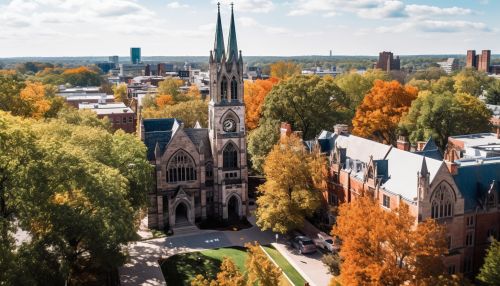Yale University
History
Yale University, one of the oldest and most prestigious institutions of higher education in the United States, was founded in 1701 in the Colony of Connecticut. It was originally known as the Collegiate School and was located in Saybrook Colony. In 1716, the school was moved to New Haven and, in 1718, it was renamed Yale College in honor of a gift from British East India Company governor Elihu Yale.
The early years of Yale were marked by a series of religious controversies. The school was founded by Congregationalist ministers who wanted to establish a place where clergy could be properly trained in the New England colonies. However, by the mid-18th century, a growing number of students were attracted to the more liberal teachings of the Enlightenment, leading to a schism between the conservative faculty and the increasingly liberal student body.


Academics
Yale University is organized into fourteen constituent schools: the original undergraduate college, the Yale Graduate School of Arts and Sciences, and twelve professional schools. Among the professional schools are the Yale School of Medicine, the Yale School of Law, and the Yale School of Architecture.
The university is known for its rigorous academic programs and its commitment to undergraduate liberal arts education. All undergraduate students are required to complete a core curriculum known as the Yale College Distributional Requirements. Yale is also known for its large number of distinguished faculty, including numerous Nobel laureates and Pulitzer Prize winners.
Campus
The Yale University campus in New Haven, Connecticut, is renowned for its beautiful architecture. The central campus covers 260 acres and includes buildings from the mid-18th century, such as Connecticut Hall, to modern designs by renowned architects such as Louis Kahn and Eero Saarinen.
The campus is home to numerous museums, including the Yale University Art Gallery, the Yale Center for British Art, and the Peabody Museum of Natural History. In addition, the campus includes several libraries, the largest of which is the Sterling Memorial Library, containing over 4 million volumes.
Student Life
Yale University has a vibrant student life. The university is known for its secret societies, the most famous of which is Skull and Bones. Yale's athletic teams compete in the Ivy League and are known as the Bulldogs. The Yale Dramatic Association and the Yale Symphony Orchestra are among the most prominent student groups.
Yale's residential college system, inspired by the colleges of Oxford and Cambridge, divides the undergraduate population into fourteen communities where students live, eat, and socialize.
Notable Alumni
Yale University has produced many notable alumni, including five U.S. Presidents, 19 U.S. Supreme Court Justices, and numerous living billionaires and foreign heads of state. Yale alumni in the sciences include the first American chemistry Nobel laureate, Josiah Willard Gibbs.
